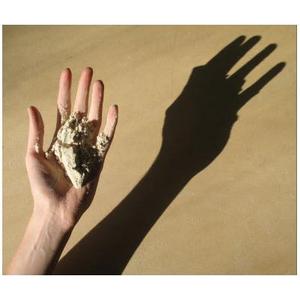This is an archive of the ArtCat Zine, 2007-2009. Please visit our new project, IDIOM.
The Peep Show of Words
The Size of Thoughts
Julia Weist
295 10th Avenue
7 February - 4 March 2008
Our bodies are defined by certain physical perimeters and constraints. While we can't transgress the material possibilities which constitute those bodies, we often challenge and explore their potential for the sake of pleasure, pain, or even pain for pleasure. When art asks us to position our bodies, that irrefutable mound of mass that we can't shake or change too drastically, in relation to the work at hand, the arising conflict is immediate because no inanimate object could ever be a distinct source of comparable measure to any of our basic faculties. Julia Weist's exhibition, The Size of Thoughts, presents a physical barrier to the work, specifically the glass window that blocks our immediate path to the objects on view. Weist's exhibition at 295 Tenth Avenue, a site curated monthly by Lumi Tan, presents sculptures made of discarded and reconfigured paperbacks and asks us to size up our own material presence in relation to these once narratively inscribed objects (books and images) that are here sculptures intended for distanced inspection and investigation. In this work, thoughts become material objects as the once immaterial narrative form of the novel is turned into shredded pieces of repurposed wood, the basic foundation for the paper upon which these words were printed is reduced to its constituting stuff. The piece, titled Lumber, made from ripped margins of discarded romance novels, is a new take on MDF, an industrial wood reborn as M.D.F, "Made of Discarded Fantasies."
Spectators can only view the exhibition like a peep show in which discarded information becomes the striptease of words and ideas. Weist creates, in effect, naked bodies made of objects that she presents in their physical wholeness for our bodies to size up. Next to the MDF of the M.D.F. we find Weist's other project: a novel about a sexy librarian whose sexual escapades get her two STDs and a novella worth of torrid adventures. The peepshow of the 295 window doesn't reveal any more than the gaze can capture (although you can buy the book and read the narrative yourself). Instead, Weist installs the book in a real MDF frame, placed next to another romance novel — the ultimate of disposable literary genres — this one written by Weist's deceased step-grandmother two years prior. The objects presented force the viewer to face the presence of the stories enclosed in a physical case that precludes any ability to delve into the ideas they would otherwise suggest or communicate. In Weist's work, thoughts can only occupy the physical size of the source material on which they were originally inscribed, the substance that makes their material composition: whether it's a novel about romance or hot sex, or the wood used to frame the book's cover turned it into something we can see but can't touch.ZINE
HOME
TIPS / COMMENTS
CATEGORIES
CONTRIBUTORS
- Greg Afinogenov
- B. Blagojevic
- Adda Birnir
- Susannah Edelbaum
- Julie Fishkin
- Paddy Johnson
- Jessica Loudis
- Christopher Reiger
- Andrew Robinson
- Peter J. Russo
- Blythe Sheldon
- S.C.Squibb
- Hrag Vartanian

